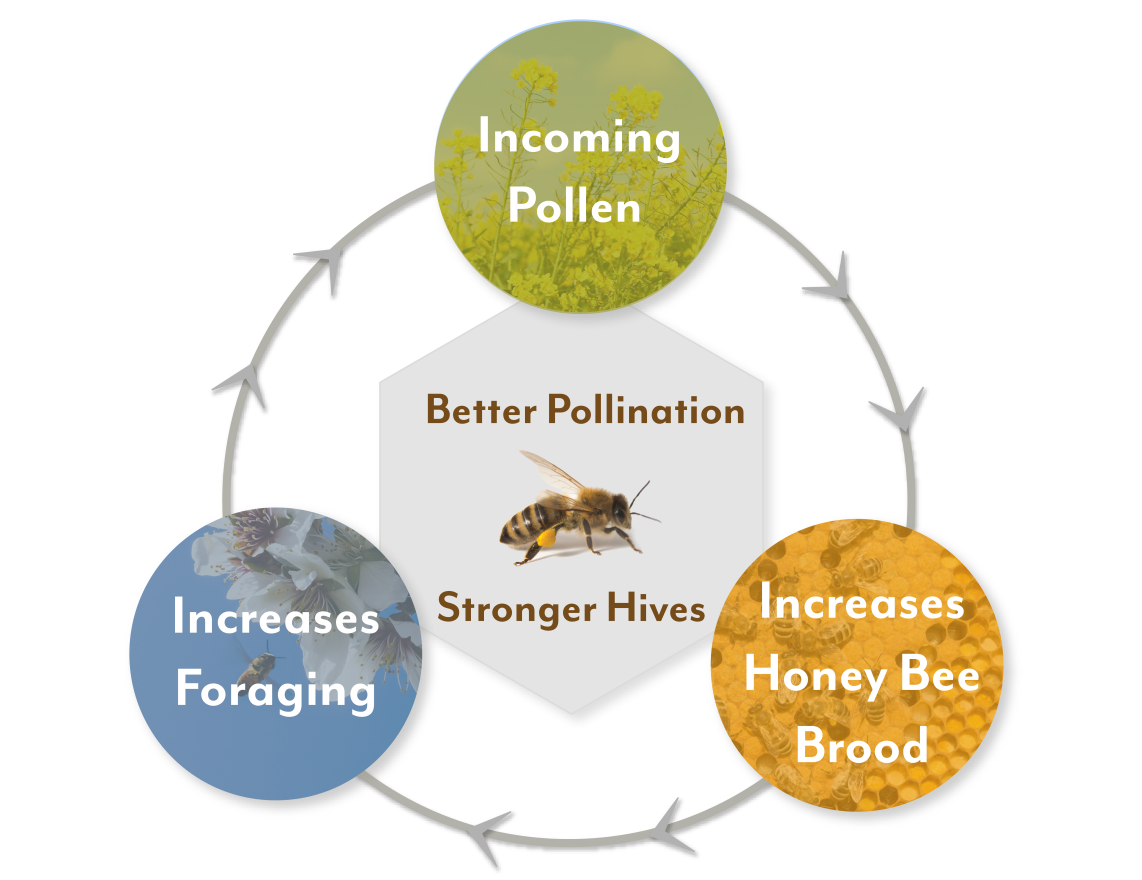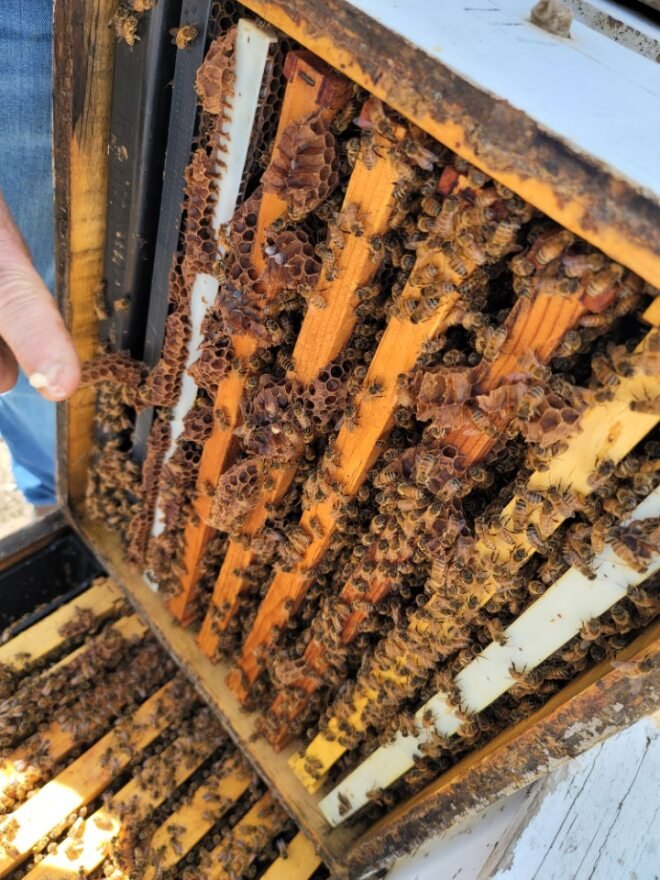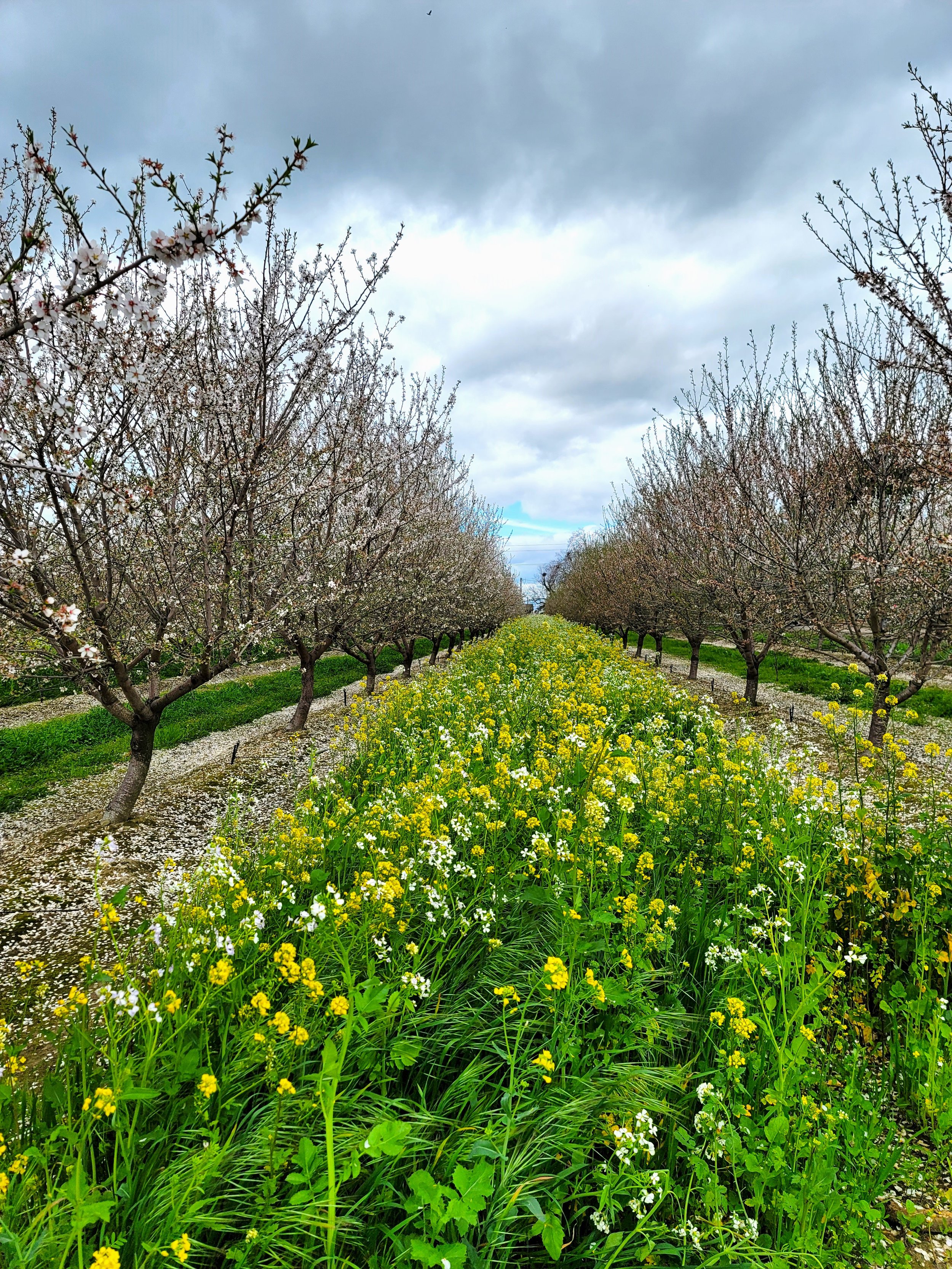Insights from the Bees: Embracing Climate Smart Beekeeping
- Understanding the critical role of beekeepers in environmental conservation and food security.
- Exploring how climate change is impacting bee health and behavior.
- Innovative climate-smart practices being adopted by beekeepers to mitigate risks, such as diverse planting and landscape management.
- Case studies of successful beekeepers implementing climate-adapted strategies.
- The importance of community education and collaboration in enhancing resilience against climate-induced challenges.
- How embracing technology and data is transforming beekeeping practices to be more adaptive and sustainable.
Conversations with a Beekeeper: Mitigating Risks Through Climate Smart Practices
Spring is well underway, which means almond bloom has come and gone and the bees have completed their important work of pollinating California’s almond orchards. Despite some wet and windy conditions, warmer temperatures prevailed, and several periods of near-perfect weather had growers and beekeepers celebrating a fruitful pollination season! The industry is now shifting gears; beekeepers have moved bees into different crops across the country and growers are tending to their quickly developing orchards. Those who grew cover crops through the Climate Smart Grant are terminating their stands and preparing orchards for yet another year of supporting pollinators through climate smart practices. I spoke with local beekeeper, Jason Miller, to discuss the various benefits of cover crops from a beekeeper’s perspective. Read on to learn more about the pollinator-friendly practices covered through the grant and how growers and beekeepers are working together to protect bee health.
Jason Miller, owner of Miller Honey Farms, is a fourth-generation beekeeper here in California. Every year, their bees get their start pollinating almonds, and despite some complications from the rainy winter, he reports that “from pollination to nut set, it was a good year.” There are many variables outside our control that determine how bloom and pollination will go. (Take it from Miller, who had about 200 colonies washed away in a flash flood this year!) Factors such as weather, temperature, frost, hive strength, orchard location, and soil type can play a significant role in the season’s outcomes. Miller supposes that if you can “retain control of your pollinators, keep them healthy, and keep them in your orchards,” the less likely it is for those unknown elements to have adverse impacts in your orchard. By planting cover crops to help in managing bee health, you can build a better defense against these factors and foster a more resilient system for the bees and your trees.
Using the example of especially cold winters, Miller says “it’s all about the strong colonies.” He explained that in winter, when almonds are in bloom, a beehive doesn’t naturally want to be big, but instead, like everything else in winter, bees slow down and rest. A weaker hive might end up spending most of its resources keeping warm instead of building brood and foraging in response to the almond bloom. By providing additional natural forage for bees during this critical period, a grower can “retain control” and mitigate the risks of unpredictable conditions.
When bees find a reliable source of nutritious food, it triggers a positive response throughout the entire hive. Incoming pollen from cover crops stimulates the hive to begin its reproduction cycle and start increasing its population. As the number of bees increases inside the colony, more bees are freed up for foraging. This leads to even more pollen collection which results in vigorous hive strength and increased pollination in the orchard overall. By planting early blooming cover crop varieties in the fall, growers can initiate this hive response before the almond bloom. Even if cold or wet weather is on the horizon, bees with access to cover crops are more likely to be geared up and ready at the first sign of good weather.

Early blooming cover crops can signal the coming of spring, which encourages bees to break their winter dormancy and begin the foraging cycle. Bare soils that lack forage and diversity compel bees to stay inside to keep warm, signaling that winter is not yet over! Image Credit: Project Apis m.
Another “unknown” that Miller has experienced first-hand, is the potential of unintentional pesticide exposure from neighboring farms. As the almond bloom progresses and flowers open each day, pollen released from the anthers is collected and removed by the bees by mid-afternoon. (If you see bees carrying pollen late in the day, after 3:00 or 4:00 pm, you probably don’t have enough bees in the orchard.) When the bees have stripped that day’s pollen, they will go looking for other sources of food. Having flowers in the orchard from a blooming cover crop will keep the bees in your orchard.
Jason shared a story about an almond orchard that was experiencing significant bee die-offs at the tail end of bloom. They had to remove bees earlier than necessary; rushing to move their bees due to an unknown source of pesticide poisoning. Without a diversity of forage in the orchard, bees were traveling to nearby farms and getting exposed to pesticides. However, the next year the grower planted cover crops, which kept the floral resources local and anchored the bees right there in the orchard. Miller says, “Like night and day, they stopped seeing the pesticide kill.” In the morning, bees pollinated the almonds, and throughout the day they stayed in the cover crop with no need to scout for additional sources. They were able to keep the bees in longer without worrying about them getting into trouble at nearby farms.

Caption: PAm.’s Annual Clover Mix, a reliable nitrogen-fixer, can bloom from March – June to extend forage resources for pollinators through the season. Image Credit: Project Apis m. – Seeds for Bees® participant photo submission
“Planting cover crops and bee habitat is a win-win for the grower and the beekeeper. Cover crops not only support bigger colonies but can also save your beekeeper on inputs and labor. Bees are healthier when eating a diverse, natural diet which can reduce costs for labor and artificial food sources”
— Jason Miller
Miller tells me that feeding bees artificial pollen patties “is like eating macaroni and cheese three meals a day.” Bees are not as healthy with such limited provisions; their immune systems are down, and they aren’t as vigorous or resilient as they could be.
Many beekeepers, including Miller, are willing to offer a discount on pollination services if you plant cover crops. He says, “If you’re putting your best foot forward for bee health, I’ll put by best bees forward!”

Hives that have access to natural pollen sources early in the year result in bigger colonies and increased pollination potential. Image Credit: Project Apis m.
The health of the almond industry and the bee industry are intrinsically tied. Miller suggests that taking care of your bees, whether that’s through reduced pesticides, less artificial inputs, or planting cover crops, will benefit you both at bloom time and in subsequent years. If you’re managing your orchard with pollinator health in mind, and bees start healthy in your orchard, it’s going to pay dividends. “There are more reasons to plant cover crops than may be obvious at first,” says Miller. The growers he is acquainted with who plant cover crops or hedgerows for pollinators have shared that they tend to see the connections between all these aspects of the farm. Soil health, nematodes, pests, weed pressure, nutrients, and crop productivity are all positively impacted, he says, “all the benefits start to add up.”

Planted in a Blue Diamond orchard through the Climate Smart Grant, this cover crop stand seen here was blooming on February 29, 2024. Image Credit: Project Apis m.
This year marks the second year of Blue Diamond’s USDA Climate Smart Grant. Rolling out over five years, the project promotes the adoption of soil-building and pollinator-friendly practices in California’s almond farms. A response to the growing market of eco-conscious consumers, the grant also aims to expand market opportunities and premium prices for sustainably grown almonds. You can receive payments and free materials for the following practices:
- Cover Cropping
-
- Planting a temporary crop, typically flowering and nitrogen-fixing species in between orchard rows
- Receive no-cost seeds and a $35/acre incentive payment
- Conservation Cover
-
- Planting perennial, vegetative plants on idle/fallow or marginal land
- Receive no-cost seeds and a $50/acre incentive payment
- Hedgerows
-
- Planting permanent, perennial woody shrubs and trees
- Receive no-cost plant material and a $8/linear ft. incentive payment
These “climate smart” practices, like installing permanent pollinator habitat and planting winter cover crops in orchard rows, provide a broad range of benefits for your orchard. In addition to increased pollination and bee health, these practices help to reduce erosion, suppress weeds, improve water-use efficiency, and improve overall soil health.
Last year, Blue Diamond growers planted cover crops in over 17,000 acres through the Climate Smart Grant (that’s an area of land larger than the entire island of Manhattan!). Blue Diamond partnered with Project Apis m.’s Seeds for Bees® program to provide seed and technical assistance to support growers to adopt cover crops and conservation cover in their orchards. Grant applications are open now through the end of June; if you are interested in planting cover crops for pollinator health and want to get paid for these practices, apply today!
Applications are open! Learn more at USDA Climate-Smart Grant | Blue Diamond Growers
Project Apis m. (PAm)Climate smart practicesAlmond orchardsPollinationCover cropsbeekeepersJason MillerMiller Honey FarmsHoney bee healthPollinator-friendlyPesticide exposureNatural forageUSDA Climate Smart GrantSeeds for BeesBlue Diamond GrowersSoil healthCrop productivityNitrogen-fixing speciesConservation coverHedgerowsEcosystem benefits
